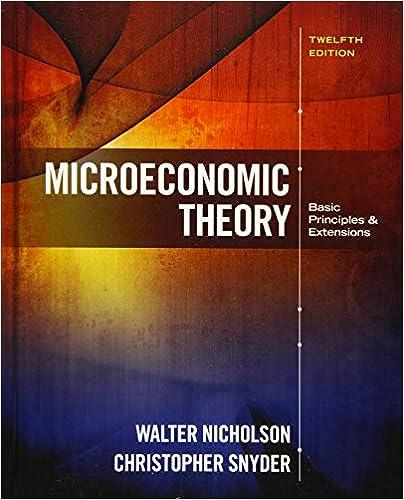Graphing complements Graphing complements is complicated because a complementary relationship between goods (under Hicks definition) cannot occur
Question:
Graphing complements Graphing complements is complicated because a complementary relationship between goods (under Hicks’ definition)
cannot occur with only two goods. Rather, complementarity necessarily involves the demand relationships among three
(or more) goods. In his review of complementarity, Samuelson provides a way of illustrating the concept with a two-dimensional indifference curve diagram (see the Suggested Readings). To examine this construction, assume there are three goods that a consumer might choose. The quantities of these are denoted by x1, x2, and x3. Now proceed as follows.
a. Draw an indifference curve for x2 and x3, holding the quantity of x1 constant at x0 1. This indifference curve will have the customary convex shape.
b. Now draw a second indifference curve for x2, x3 that provides the same level of utility as in part (a), holding x1 constant at x0 1 2 h (this new indifference curve will be to the right of the old one). For this new indifference curve, show the amount of extra x2 that would compensate this person for the loss of x1; call this amount j. Similarly, show that amount of extra x3 that would compensate for the loss of x1 and call this amount k.
c. Suppose now that an individual is given both amounts j and k, thereby permitting him or her to move to an even higher x2, x3 indifference curve. Show this move on your graph, and draw this new indifference curve.
d. Samuelson now suggests the following definitions:
• If the new indifference curve corresponds to the indifference curve when x1 5 x0 1 2 2h, goods 2 and 3 are independent.
• If the new indifference curve provides more utility than when x1 5 x0 1 2 2h, goods 2 and 3 are complements.
• If the new indifference curve provides less utility than when x1 5 x0 1 2 2h, goods 2 and 3 are substitutes.
Show that these graphical definitions are symmetric.
e. Discuss how these graphical definitions correspond to Hicks’ more mathematical definitions given in the text.
f. Looking at your final graph, do you think that this approach fully explains the types of relationships that might exist between x2 and x3?
Step by Step Answer:

Microeconomic Theory Basic Principles And Extensions
ISBN: 9781305505797
12th Edition
Authors: Walter Nicholson, Christopher M. Snyder






